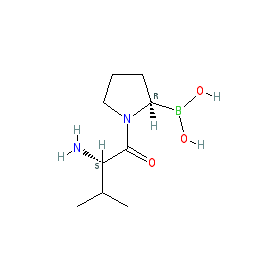GtoPdb is requesting financial support from commercial users. Please see our sustainability page for more information.
|
Synonyms: compound 1 [PMID: 18783201] | PT-100 | PT100 | Val-boro-pro | Val-boroPro
Compound class:
Synthetic organic
Comment: Talabostat (PT-100, or Val-boroPro) is a compound with potent anti-tumour activity. It is a non-selective inhibitor of post-proline-cleaving serine proteases (DPP enzymes). Talabostat activates macrophages at least in part via inhibition of the serine peptidase, fibroblast activation protein (FAP), an action that has been examined for anti-cancer utility [2,4-5] and anti-fibrotic potential [3]. More recently talabostat has been reported as an inhibitor of the cytosolic serine dipeptidyl peptidases DPP8 and DPP9, and that inhibition of these related enzymes stimulates the immune system via the selective promotion of proinflammatory cell death (pyroptosis) of monocytes and macrophages [6]. This process involves DPP8/9-induced activation of the NOD-like pattern recognition receptor NLRP1, a protein that acts as an inflammasome sensor, followed by activation of pro-caspase-1 and eventually to pyroptosis [7].
Ligand Activity Visualisation ChartsThese are box plot that provide a unique visualisation, summarising all the activity data for a ligand taken from ChEMBL and GtoPdb across multiple targets and species. Click on a plot to see the median, interquartile range, low and high data points. A value of zero indicates that no data are available. A separate chart is created for each target, and where possible the algorithm tries to merge ChEMBL and GtoPdb targets by matching them on name and UniProt accession, for each available species. However, please note that inconsistency in naming of targets may lead to data for the same target being reported across multiple charts. ✖ |
|
|||||||||||||||||||||||||||||||||||
| References |
|
1. Connolly BA, Sanford DG, Chiluwal AK, Healey SE, Peters DE, Dimare MT, Wu W, Liu Y, Maw H, Zhou Y et al.. (2008)
Dipeptide boronic acid inhibitors of dipeptidyl peptidase IV: determinants of potency and in vivo efficacy and safety. J Med Chem, 51 (19): 6005-13. [PMID:18783201] |
|
2. Eager RM, Cunningham CC, Senzer NN, Stephenson Jr J, Anthony SP, O'Day SJ, Frenette G, Pavlick AC, Jones B, Uprichard M et al.. (2009)
Phase II assessment of talabostat and cisplatin in second-line stage IV melanoma. BMC Cancer, 9: 263. [PMID:19643020] |
|
3. Egger C, Cannet C, Gérard C, Suply T, Ksiazek I, Jarman E, Beckmann N. (2017)
Effects of the fibroblast activation protein inhibitor, PT100, in a murine model of pulmonary fibrosis. Eur J Pharmacol, 809: 64-72. [PMID:28506908] |
|
4. Li M, Li M, Yin T, Shi H, Wen Y, Zhang B, Chen M, Xu G, Ren K, Wei Y. (2016)
Targeting of cancer‑associated fibroblasts enhances the efficacy of cancer chemotherapy by regulating the tumor microenvironment. Mol Med Rep, 13 (3): 2476-84. [PMID:26846566] |
|
5. Narra K, Mullins SR, Lee HO, Strzemkowski-Brun B, Magalong K, Christiansen VJ, McKee PA, Egleston B, Cohen SJ, Weiner LM et al.. (2007)
Phase II trial of single agent Val-boroPro (Talabostat) inhibiting Fibroblast Activation Protein in patients with metastatic colorectal cancer. Cancer Biol Ther, 6 (11): 1691-9. [PMID:18032930] |
|
6. Okondo MC, Johnson DC, Sridharan R, Go EB, Chui AJ, Wang MS, Poplawski SE, Wu W, Liu Y, Lai JH et al.. (2017)
DPP8 and DPP9 inhibition induces pro-caspase-1-dependent monocyte and macrophage pyroptosis. Nat Chem Biol, 13 (1): 46-53. [PMID:27820798] |
|
7. Okondo MC, Rao SD, Taabazuing CY, Chui AJ, Poplawski SE, Johnson DC, Bachovchin DA. (2018)
Inhibition of Dpp8/9 Activates the Nlrp1b Inflammasome. Cell Chem Biol, 25 (3): 262-267.e5. [PMID:29396289] |







